Using AI in Mindfulness Facilitation: Survey Results and 4 Key Takeaways

By The Mindful Leader Team
In the last few months, our field has been rattled by AI, with primary two camps - those who are excited and thrilled about the possibilities and those who are concerned with the ethical and moral implications. Over the last few months, we have explored ChatGPT, AI Tools, the ethics of AI and spirituality in a series of articles you can find here. With all the buzz around AI, we decided to conduct a comprehensive survey and get a pulse from the field about the current use and sentiment. We launched the survey in June 2023 through our newsletter and received 50 responses. The results offer insights and surprising takeaways that will help prepare for the trends and possibilities ahead. In this article, we present the survey findings and 4 key takeaways.
Results and Analysis
Figure 1
One of the first questions we asked was whether AI usage in the delivery of mindfulness training had already begun in the respondents’ workplace. Our aim was to gain an understanding of how novel this concept is within the respondent’s organizations. As you can see in Figure 1, only 12% of respondents’ workplaces have begun integrating AI into their mindfulness training delivery. This shows us that this topic, and the usage of AI, is still somewhat novel and has a lot of potential for growth within organizations.
Figure 2
After gaining an understanding of the current usage level of AI within the workplace, we wanted to learn about any future plans that might be taking place within those same organizations. To start, we can see that the majority of respondents chose not applicable / don’t know. This data is rather valuable in that it shows us that there is still a lot to be taught about the usage of AI. There are still large groups of people who are still unsure and not knowledgeable about the topic. This is further shown by the fact that 2% of respondents selected that the use of AI in their organization will never happen. It brings up the interesting question of, why never? Is it due to a lack of understanding, or even fear?
The next highest response goes to “create engaging and interactive activities and exercises for mindfulness sessions.” We then also see a high level of response for both “generating guided meditation scripts” and “answering questions and providing explanations on mindfulness practices and concepts.” These three responses really begin to highlight some of the exciting ways in which AI can truly help aid and guide mindfulness training within organizations. AI is a tool that can provide support throughout the process. This is further supported by the responses to “creation of presentations” and “creation of materials.” AI has the ability to provide a strong foundation for materials that can then be built upon with the strength of human creativity.
Figure 3
Now that we know that future plans of integrating AI into the delivery of mindfulness training are present within the respondents’ organizations, we wanted to learn more about what challenges or holdbacks might be in place within them. As we saw in Figure 1, there are not presently many organizations that are already integrating AI, so why is that?
When looking at Figure 3, we can see that the majority of respondents selected “lack of understanding of how AI can be used in mindfulness practices.” This confirms for us that, yes, there is a gap in knowledge present and that is affecting the levels of AI usage. We also see a high level of responses to “lack of technical expertise” which further emphasizes that there is a lack of understanding in play here. When looking at the responses to two other options “fear of AI” and “resistance from employees or users”, we can see that there is a role being played by fear here as well. Which, fear of AI can be caused by a lack of understanding of it. Furthermore, the responses to “limited budget” could also be due to a lack of understanding. If a strong grasp of AI was held by those within the organization, the benefits of it could be presented more clearly and thus help gain budgetary support for it.
Figure 4
Next, we decided to gauge the respondents’ satisfaction levels with the current use of AI in delivering mindfulness training in their organizations. As you can see in Figure 4, the majority of respondents indicated that they are very unsatisfied with the current levels of use. This is an exciting response as it shows that even though there is a lack of understanding, and sometimes even fear, about AI, there is still interest in learning about it and integrating it into organizations.
Figure 5
Now that we know there is an interest in seeing more integration of AI, we wanted to know if the outlooks about its usage are positive or negative. When looking at Figure 5, we can see that there were more respondents leaning towards a positive outlook than there were ones that leaned negative. We also have a decent group right in the middle. The interesting points of discussion coming from Figure 5 would be to learn more about those who answered “not beneficial at all” and those who answered “extremely beneficial.” By examining the reasoning behind the two extremes, we could learn more about the current perspectives of AI. In the same vein, learning more about those who answered strictly in the middle, what kept them from leaning negatively or positively?
Figure 6
Next, we wanted to learn about the future levels of integration of AI within the respondents' organizations. We did so by asking the respondents how they saw the usage of AI changing in terms of frequency. As shown in Figure 6, the majority of respondents are in the middle and thus leads us to believe that the majority of respondents are unsure about the future of its usage. However, overall, we do see more respondents leaning towards the usage of AI increasing rather than decreasing.
Figure 7
Next, we wanted to gain an understanding of what the respondents would be most interested in learning about AI. When looking at Figure 7, we can see that the majority of respondents chose “create engaging and interactive activities and exercises for mindfulness sessions.” However, there still was a large portion of respondents chose not applicable / don’t know. This adds to our understanding that there is a lack of understanding as the respondents are not even sure where to begin in learning. We also can’t ignore that some respondents would have chosen this response for the not applicable portion and did so because they are not interested in learning more about AI and increasing its usage level within their organization. This resistance continues to be present throughout the survey.
Figure 8
To further our understanding of what respondents would be most interested in learning, we asked them for their second-highest choice of learning topic. For this question, we did see a majority of respondents select “not applicable / don’t know.” The next two highest responses were “create engaging and interactive activities and exercises for mindfulness sessions” and then “generate guided meditation scripts.”
Learning where the interest lies for the respondents helps us plan for the future as we want to provide support around integrating the use of AI in the delivery of mindfulness training.
“What else would be important for you to learn in this training?”
We moved to some open-ended questions to dive deeper into the thought process of the respondents.
One of the most common responses, and rightly so, was about the ethics of using AI within Mindfulness training. One respondent even went so far as to say “ethically negligent, spiritually impossible, developmentally impossible.” It is true that the ethics of using AI within mindfulness training is an incredibly important topic to address. It seems the main concern lies within the lack of humanity in AI and how, without humanity, are you truly facilitating mindfulness. This is confirmed by one respondent who said “AI is not a solution for us. Staff crave human connection, dislike mechanistic solutions.” This shows us that there is an opportunity to show how AI can be used to assist (not lead) in the delivery of mindfulness training and that is still possible to include human input and, thus, humanity. We can see that there is an interest in learning just that shown by two respondents who said “I feel there is a lot of resistance to AI in terms of how it can support Mindfulness, because mindfulness is seen as being taught as an embodied human to human experience. I would love to see research around this explored (if there is any). How will mindfulness teaching change with AI? Will we need trained mindfulness teachers or will AI be able to do this job?” and “When and when not to use AI for mindfulness.”
We also saw a lot of respondents answering along the lines of just wanting to learn and understanding how to use AI as a whole. This lack of knowledge has shown up throughout the survey responses and showcases a unique opportunity to help teach those how to ethically use AI and integrate it into organizations.
“What concerns do you have about using AI that would limit your willingness to take this type of training?”
Now that we know what is important to the respondents, we wanted to learn what holdbacks they might have. We again saw many responses commenting on the ethics of using AI within this sphere. There is a genuine concern that integrating AI will lead to unethical outcomes. We saw responses such as “privacy”, “Intellectual property rights infringement” and “misleading information.” This further showcases to us that there is a need to discuss the ethical implications of using AI within mindfulness training and that is a topic that cannot be overlooked.
Furthermore, we again saw a genuine concern for the lack of humanity behind AI. We saw responses such as “Robbing students of authentic teaching,” “Losing the human touch,” and “AI training won't actually build community.”
4 Key Takeaways
#1 Significant potential for the growth of AI usage in mindfulness facilitation: The survey indicates that AI usage in the delivery of mindfulness training is still relatively novel within respondents' organizations, with Figure 1 showing that only 12% have integrated AI in this context. This suggests that there is significant potential for the growth and exploration of AI applications in mindfulness training. Furthermore, when looking at Figure 6, we can see that the majority of the respondents see the use of AI increasing over the next 12 months and Figure 5 shows us that the majority of respondents believe that further incorporation of AI into their organization will be a beneficial thing.
#2 Lack of knowledge about utilizing AI and dissatisfaction with its current usage level: The survey reveals that a large number of respondents are unsure about AI's applications and benefits in mindfulness training. This lack of understanding is evident from both the current low integration rate seen in Figure 1 and the high percentage of respondents choosing "not applicable / don't know" when asked about future plans seen in Figure 2. Additionally, in Figure 3, we can see that the majority of respondents see a lack of understanding as their biggest challenge when integrating AI into their organizations. Furthermore, in Figure 4, despite the low integration rate, we can see that the majority of the respondents are unsatisfied with the current usage levels of AI in their organization.
#3 Fear and resistance when it comes to integrating AI: Some respondents expressed fear and resistance towards using AI in mindfulness training, potentially due to a lack of understanding about its capabilities and implications. This fear may be hindering the adoption of AI in organizations. These feelings are made evident when reviewing the responses to the open-ended questions. Furthermore, there is a genuine concern about the ethical implications of using AI in mindfulness training. Respondents worry about the lack of humanity, privacy issues, intellectual property rights infringement, and misleading information that could result from AI integration. The survey also reveals in the open-ended questions that many respondents express concerns about the potential lack of human touch in AI-driven mindfulness training. They worry that relying too much on AI may diminish the authentic teaching experience and hinder the development of a sense of community among participants.
#4 Interest in learning more about the ways AI can benefit mindfulness facilitation: We can see that respondents recognize the potential of AI in Figure 2. It shows us the different ways that respondents see the use of AI benefiting them, such as in the creation of materials and engaging exercises. In Figure 5, we see that the majority of respondents believe that the integration of AI will be beneficial for their organization. We can infer that with most respondents having a positive outlook, there is an interest in learning more about using AI. This can also be seen in Figures 7 and 8 where we asked respondents what topics they would be most interested in learning about in regards to AI. We saw a variety of interest in topics with the two topics with the most interest being the creation of engaging and interactive mindfulness exercises and how to generate guided meditation scripts.
Overall, the survey highlights the need for more education and awareness-building around AI's applications and ethical considerations in mindfulness training. Organizations can benefit from exploring AI's supportive role in creating engaging experiences and materials while addressing concerns about its impact on human connection and ethics.
What other questions would you like to see the answers to when it comes to AI in the workplace? Did you find any of these results surprising? Share your thoughts in the comments below!
Eager to learn how to use ChatGPT and other AI tools? Great news – I'm developing a course to teach you precisely that. Sign up here, and we'll make sure you're in the know when it comes to course launch details.

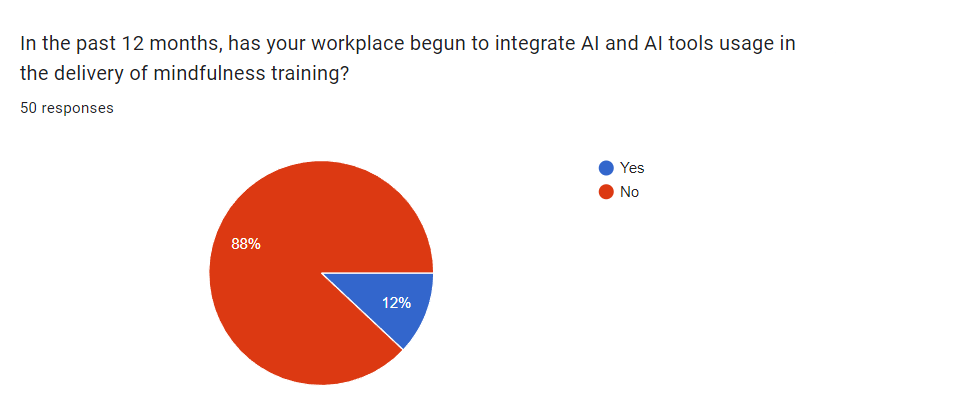
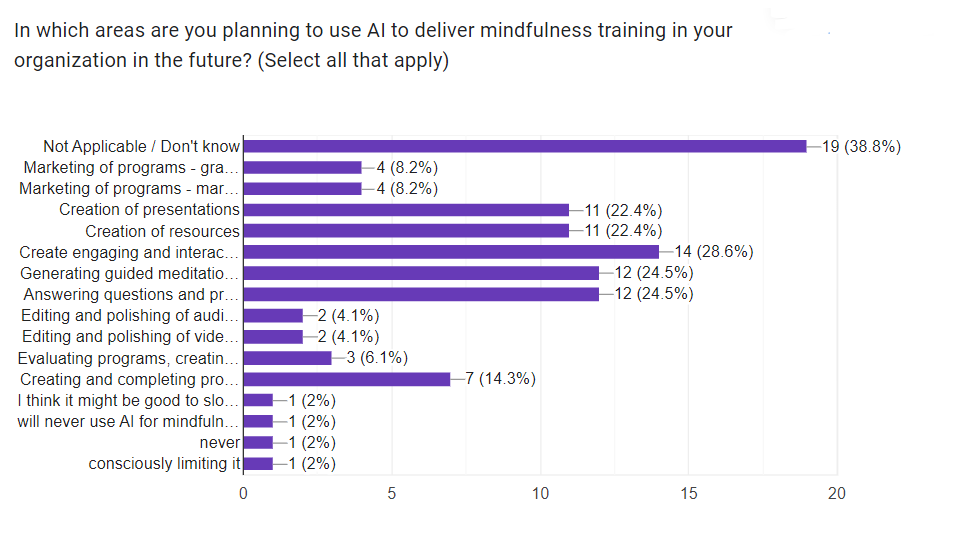
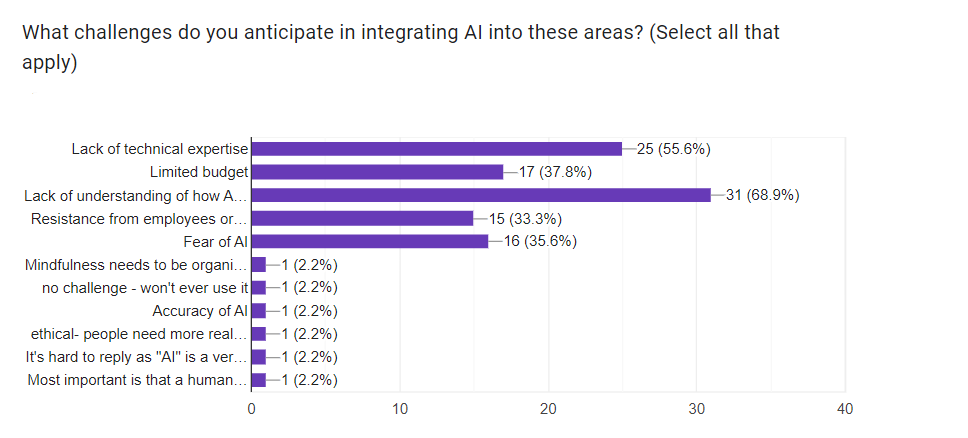
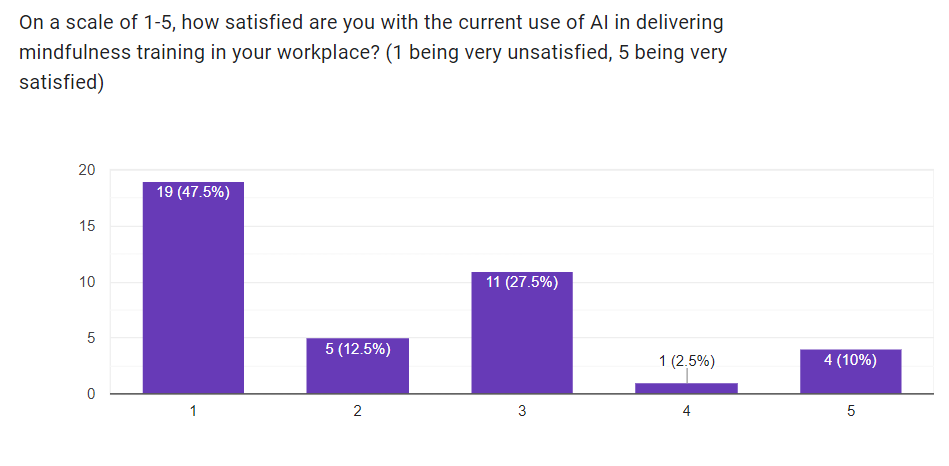


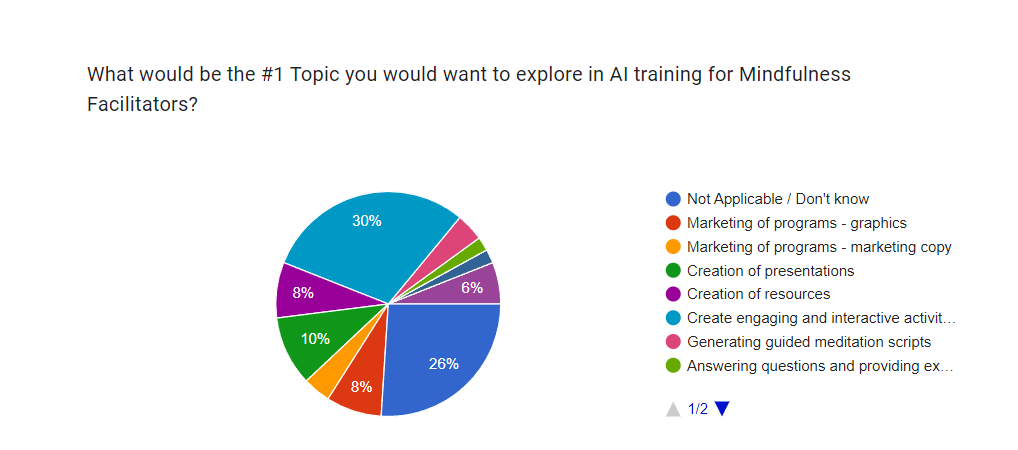

0 comments
Leave a comment